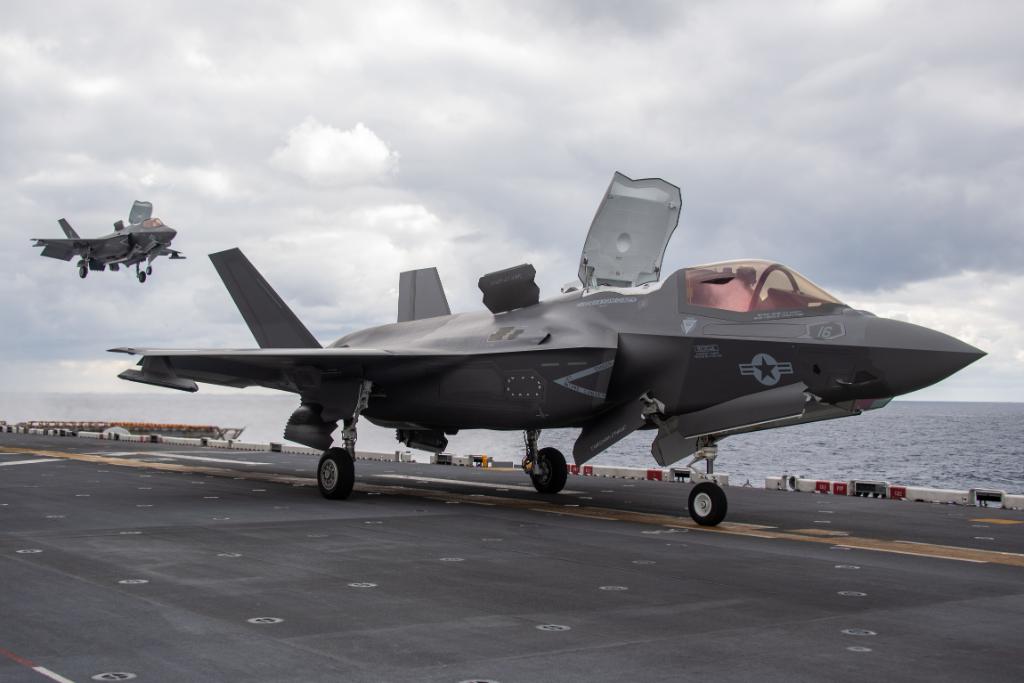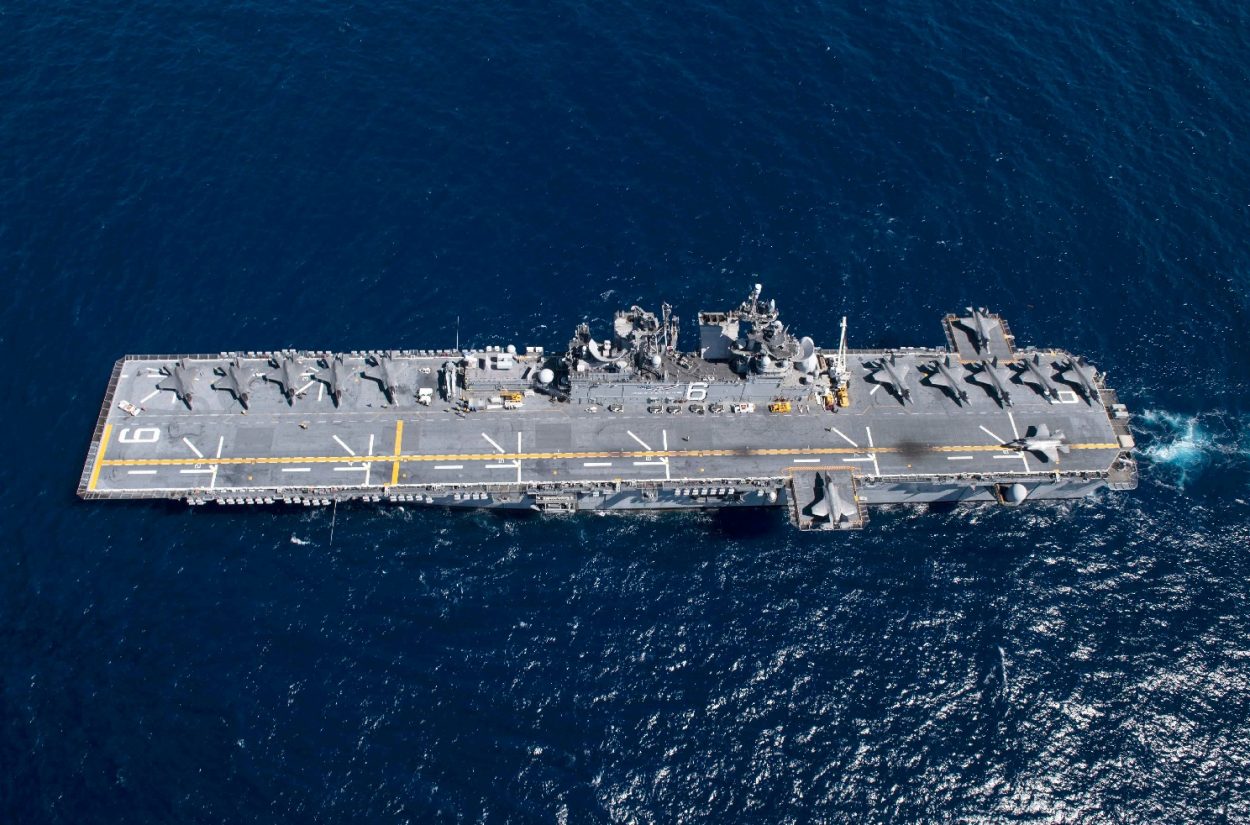Three squadrons of US Marine Corps F-35Bs will assemble aboard the USS Tripoli (LHA-7) in early April to thoroughly evaluate the ‘Lightning Carrier’ concept.
The ‘Lighting Carrier’ concept was first presented by the US Marine Corps (USMC) in their 2017 Marine Aviation Plan. Under this, the USMC aims to deploy 16-20 F-35B fighter jets to its amphibious assault ships, turning them into ‘Lightning Carriers’ (CV-L).
Incapable Against J-20 Fighters – US Air Force Says ‘Not Ready For 21st-Century Battle’ With China Due To Outdated AWACS
The ‘Lightning Carrier’ idea has evolved from the classic “Harrier Carrier” concept which saw amphibious assault ships being utilized to carry AV-8B Harrier jump aircraft.
In the upcoming test, a total of 20 F-35Bs will conduct sustained operations, followed by surge operations from the USS Tripoli, The War Zone reported. The activity will evaluate the Marines’ ability to operate two entire F-35B squadrons from a single ship at the same time.
Given how critical it is to the service’s long-term strategy, it might have a significant impact on what the stealthy planes can contribute to the war in the future.

Yuma-based Marine Operational Test and Evaluation Squadron One (VMX-1), Marine Fighter Attack Squadron 211 (VMFA-211), and Marine Fighter Attack Squadron 225 (VMFA-225) are among the squadrons that will constitute the 20-jet force.
VMX-1 is apparently serving as the USMC’s test squadron, and it has recently begun testing on ‘spot 9’ near the ship’s rear end in an effort to allow it a second ‘Unaided Night Landing Spot’ for the F-35B. This could be critical in the Lightning Carrier trials to come.
Flying Cars In 3 Years? Japan Sets 2025 Target For ‘Innovation Of The Century’, To Run eVTOL Services During Osaka World Expo
Moreover, in January, the USMC F-35B from Marine Strike Fighter Attack Squadron (VMFA) 122 successfully landed for the first time on the USS Tripoli, an amphibious assault ship.
Lightning Carriers
In 2019, the Navy and Marine Corps tested the ‘Lightning Carrier’ concept of packing an amphibious assault ship with F-35B Lightning II Joint Strike Fighter jets. The same month, an image of the USS America’s crammed flight deck with 13 F-35Bs and one MH-60S stowed in front of the bridge got attention.
The squadron was evaluating the new America class’s potential to operate a large number of F-35s from its flight deck, which is substantially smaller than a Nimitz class aircraft carrier.

Like their counterparts, the USS America and the USS Tripoli do not have a floodable well deck. Instead, they were built with extra space to support aircraft like the F-35B and all that goes with them, such as fuel, maintenance people, space and equipment, and ammunition.
Colonel Benjamin ‘Brutuz’ Hutchins, the Air Warfare System TACAIR Branch Head at the Pentagon, told The Warzone about the upcoming exercise, “The Lightning Carrier concept has been kicked around for a while and is actually a test point that they are finishing on OT-1 (Operational Test-One) with COTEF (Commander Operational Test and Evaluation Force).”
China, Turkey Build Two ‘Record-Breaking’ Suspension Bridges; One Connects Europe To Asia In Mere 6 Minutes
VMFA-211 has just arrived from a historic maiden seven-month deployment onboard HMS Queen Elizabeth. They flew ten of their jets alongside the Royal Air Force 617 Squadron’s “Dambusters.” Meanwhile, VMFA-225 has become the fifth operational USMC F-35B Squadron, after transitioning from the F/A-18D Hornet. As part of the huge Winter Fury ’22 exercise, both VMFA-211 and VMFA-225 have been conducting high-level training.
The other F-35B squadron, VMFA-122, is working with the 13th Marine Expeditionary Unit (MEU) about putting ten F-35Bs on an amphibious assault ship (with a well deck) with the rest of the MEU’s aircraft. Hutchins said, “VMFA-122s task is getting with the MEU Commander in order to have a full ACE capability of 10 MV-22s and all the other helicopters with 10 F-35Bs. Some of the helicopters will have to go to the LPDs.”
Hutchins said that they aren’t seeking to replace the CVN fleet with a Lightning Carrier, therefore the idea isn’t a ‘baseline one.’ “It’s simply another tool in the toolbox. This is a way to bolster power quickly. One of the challenges, while looking over the enormous Pacific, will be the capacity to quickly pivot and enable forces to be”.
Lightning carriers, although less effective than supercarriers, provide a significant potential to expand naval firepower. The amphibious assault ships could be incorporated into carrier task forces to boost airpower, or they might be deployed in separate amphibious readiness groups to disperse the force for increased survivability and lethality.
- Contact the author at ashishmichel@gmail.com
- Follow EurAsian Times on Google News




